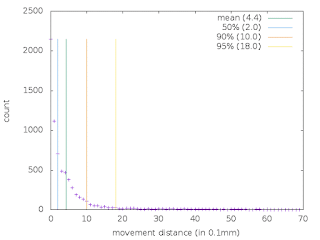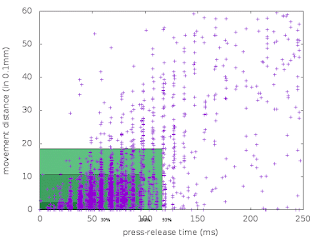A short while ago, I asked a bunch of people for long-term touchpad
usage data (specifically: evemu recordings). I currently have 25 sets of data, the shortest of which has
9422 events, the longest of which has 987746 events. I requested that
evemu-record was to be run in the background while people use their touchpad normally. Thus the
data is quite messy, it contains taps, two-finger scrolling, edge scrolling,
palm touches, etc. It's also raw data from the touchpad, not processed by libinput. Some care has to be taken with analysis, especially since
it is weighted towards long recordings. In other words, the user with 987k
events has a higher influence than the user with 9k events. So the data is useful for looking for patterns that can be
independently verified with other data later. But it's also useful for
disproving hypothesis, i.e. "we cannot do $foo because some users' events show $bla".
One of the things I've looked into was tapping.
In libinput, a tap has two properties: a time threshold and a movement
threshold. If the finger is held down longer than 180ms
or it moves more than 3mm it is not a tap. These
numbers are either taken from synaptics or just guesswork (both, probably).
The need for a time-based threshold is obvious: we don't know whether the user is
tapping until we see the finger up event. Only if that doesn't happen within
a given time we know the user simply put the finger down. The movement
threshold is required because small movements occur while tapping, caused by
the finger really moving (e.g. when tapping shortly before/after a pointer
motion) or by the finger center moving (as the finger
flattens under pressure, the center may move a bit). Either way, these
thresholds delay real pointer movement, making the pointer less reactive
than it could be. So it's in our interest to have these thresholds low to
get reactive pointer movement but as high as necessary to
have reliable tap detection.
General data analysis
Let's look at the (messy) data. I wrote a script to calculate the time delta and
movement distance for every single-touch sequence, i.e. anything with two or
more fingers down was ignored. The script used a range of 250ms and
6mm of movement, discarding any sequences outside those thresholds. I also
ignored anything in the left-most or right-most 10% because it's likely that
anything that looks like a tap is a palm interaction [1]. I ran the script
against those files where the users reported that they use tapping (10
users) which gave me 6800 tap sequences. Note that the ranges are purposely
larger than libinput's to detect if there was a significant amount of attempted taps
that exceed the current thresholds and would be misdetected as non-taps.
Let's have a look at the results. First, a simple picture that merely prints
the start location of each tap, normalised to the width/height of the
touchpad. As you can see, taps are primarily clustered around the center but
can really occur anywhere on the touchpad. This means any attempt at
detecting taps by location would be unreliable.
 Normalized distribution of touch sequence start points (relative to touchpad width/height)
Normalized distribution of touch sequence start points (relative to touchpad width/height)
You can easily see the empty areas in the left-most and right-most 10%, that is an artefact of the filtering.
The analysis of time is more interesting: There are spikes around the 50ms
mark with quite a few outliers going towards 100ms forming what looks like a
narrow normal distribution curve. The data points are overlaid with markers
for the mean [2], the 50 percentile, the 90 percentile
and the 95 percentile [3]. And the data says: 95% of events fall below
116ms. That's something to go on.
 Times between touch down and touch up for a possible tap event.
Times between touch down and touch up for a possible tap event.
Note that we're using a 250ms timeout here and thus even look at touches
that would not have been detected as tap by libinput. If we reduce to the
180ms libinput uses, we get a 95% percentile of 98ms, i.e. "of all taps currently detected as taps, 95% are 98ms or shorter".
The analysis of distance is similar: Most of the tap sequences have little
to no movement, with 50% falling below 0.2mm of movement. Again the
data points are overlaid with markers for the mean, the 50 percentile,
the 90 percentile and the 95 percentile. And the data says: 95% of events
fall below 1.8mm. Again, something to go on.
 Movement between the touch down and the touch up event for a possible tap (10 == 1mm)
Movement between the touch down and the touch up event for a possible tap (10 == 1mm)
Note that we're using a 6mm threshold here and thus even look at touches
that would not have been detected as tap by libinput. If we reduce to the
3mm libinput uses, we get a 95% percentile of 1.2mm, i.e. "of all taps currently detected as taps, 95% move 1.2mm or less".
Now let's combine the two. Below is a graph mapping times and distances from
touch sequences. In general, the longer the time, the longer the more
movement we get but most of the data is in the bottom left. Since doing
percentiles is tricky on 2 axes, I mapped the respective axes individually.
The biggest rectangle is the 95th percentile for time and distance, the
number below shows how many data points actually fall into this rectangle.
Looks promising, we still have a vast majority of touchpoints fall into
the respective 95 percentiles though the numbers are slightly lower than the individual axes
suggest.
 Time to distance map for all possible taps
Time to distance map for all possible taps
Again, this is for the 250ms by 6mm movement. About 3.3% of the events fall into the area
between 180ms/3mm and 250ms/6mm. There is a chance that some of the touches have have been short, small movements, we
just can't know by from data.
So based on the above, we learned one thing: it would not be reliable to
detect taps based on their location. But we also suspect two things now: we
can reduce the timeout and movement threshold without sacrificing a lot of
reliability.
Verification of findings
Based on the above, our hypothesis is: we can reduce the timeout to 116ms
and the threshold to 1.8mm while still having a 93% detection reliability.
This is the most conservative reading, based on the extended thresholds.
To verify this, we needed to collect tap data from multiple users in a
standardised and reproducible way. We wrote a basic website that displays
5 circles (see the screenshot below) on a canvas and asked a bunch of co-workers in two
different offices [4] to tap them. While doing so, evemu-record was running in
the background to capture the touchpad interactions. The touchpad was the
one from a Lenovo T450 in both cases.
 Screenshot of the <canvas> that users were asked to perform the taps on.
Screenshot of the <canvas> that users were asked to perform the taps on.
Some users ended up clicking instead of tapping and we had to discard
those recordings. The total number of useful recordings was 15 from the
Paris office and 27 from the Brisbane office. In total we had 245 taps (some
users missed the circle on the first go, others double-tapped).
We asked each user three questions: "do you know what tapping/tap-to-click
is?", "do you have tapping enabled" and "do you use it?". The answers are
listed below:
- Do you know what tapping is? 33 yes, 12 no
- Do you have tapping enabled? 19 yes, 26 no
- Do you use tapping? 10 yes, 35 no
I admit I kinda screwed up the data collection here because it includes
those users whose recordings we had to discard. And the questions could've been better. So I'm not going to go into
too much detail. The only useful thing here though is: the majority of users
had tapping disabled and/or don't use it which should make any potential
learning effect disappear[5]
Ok, let's look at the data sets, same scripts as above:
 Times between touch down and touch up for tap events
Times between touch down and touch up for tap events
 Movement between the touch down and the touch up events of a tap (10 == 1mm)
Movement between the touch down and the touch up events of a tap (10 == 1mm)
95th percentile for time is 87ms. 95th percentile for distance is 1.09mm.
Both are well within the numbers we expected we saw above. The combined
diagram shows that 87% of events fall within the 87ms/10.9mm box.
 Time to distance map for all taps
Time to distance map for all taps
The few outliers here are close enough to the edge that expanding the box to
to 100ms/1.3mm we get more than 95%. So it appears that our hypothesis is
correct, reducing the timeout to 116ms and 1.8mm will have a 95% detection
reliability. Furthermore, using the clean data it looks like we can use a
lower threshold than previously assumed and still get a good detection
ratio. Specifically, data collected in a controlled environment across 42 different users of varying familiarity with touchpad tapping shows that 100ms and 1.3mm gets us a 95% detection rate of taps.
What does this mean for users?
Based on the above, the libinput thresholds will be reduced to 100ms and 1.3mm.
Let's see how we go with this and then we can increase it in the
future if misdetection is higher than expected. Patches will on the
wayland-devel list shortly.
For users that don't have tapping enabled, this will not change anything.
All users who have tapping enabled will see a more responsive cursor on small
movements as the time and distance thresholds have been significantly
reduced. Some users may see a drop in tap detection rate. This is
hopefully a subconscious enough effect that those users learn to tap faster
or with less movement. If not, we have to look at it separately and see how
we can deal with that.
If you find any issues with the analysis above, please let me know.
[1] These scripts analyse raw touchpad data, they don't benefit from
libinput's palm detection
[2] Note: mean != average, the mean is less affected by strong outliers.
look it up, it's worth knowing
[3] X percentile means X% of events fall below this value
[4] The Brisbane and Paris offices. No separate analysis was done, so it is unknown whether close proximity to
baguettes has an effect to tap behaviour
[5] i.e. the effect of users learning how to use a system that doesn't work
well out-of-the-box. This may result in e.g. quicker taps from those that
are familiar with the system vs those that don't.



















